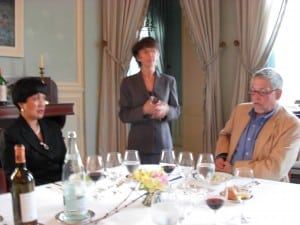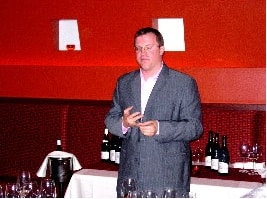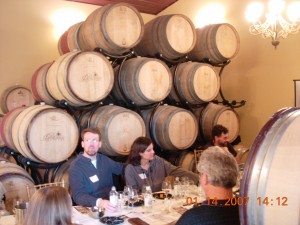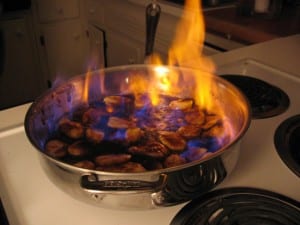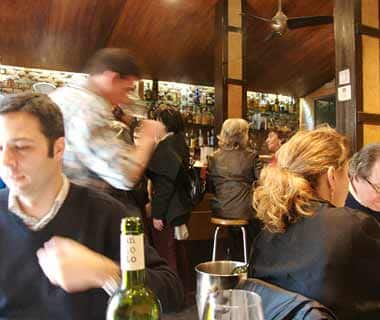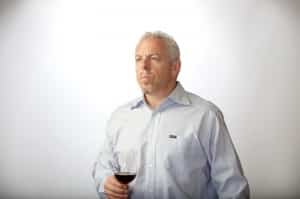Posts Tagged ‘wine tasting dc’
What IS a Wine Dinner?
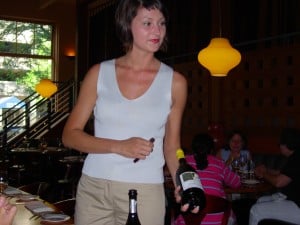 I spent over 15 years organizing and attending wine dinners at TasteDC – it is definitely my favorite part of being in a unique business! Weird as it may seem, a “wine dinner” is conceptually as confusing as a wine tasting to most people – it’s a very foreign concept to many Americans – literally! A wine dinner is in essence a multi-course dinner served with several different wines – this is the simple explanation. A GOOD/GREAT wine dinner is when the various elements come together in a wonderful symphony of an event: wine, food, timing, pairing, educational component (this usually means a speaker), and impeccable service. It sounds very snooty, but that’s primarily because it’s based on the fine dining traditions of the Old World – particularly France and Italy. So what IS a wine dinner?
I spent over 15 years organizing and attending wine dinners at TasteDC – it is definitely my favorite part of being in a unique business! Weird as it may seem, a “wine dinner” is conceptually as confusing as a wine tasting to most people – it’s a very foreign concept to many Americans – literally! A wine dinner is in essence a multi-course dinner served with several different wines – this is the simple explanation. A GOOD/GREAT wine dinner is when the various elements come together in a wonderful symphony of an event: wine, food, timing, pairing, educational component (this usually means a speaker), and impeccable service. It sounds very snooty, but that’s primarily because it’s based on the fine dining traditions of the Old World – particularly France and Italy. So what IS a wine dinner?
“A Wine Dinner Is a Meal Divided by Courses”
Most wine dinners include a menu of dishes served in three or more courses. For example, when you go out to eat at a fine dining restaurant, the menu is often broken down into Appetizers, Main Dishes, and Desserts. A Wine Dinner is a smart way for a restaurant to showcase both great wine and delicious dishes that showcase their chef’s talents. And yes, there is a formula: according to the traditional European format for a dinner (actually, any serious meal!) is begin with the lightest dishes, move on to richer dishes and finish with dessert – and yes, often there is a cheese course before dessert. A very simple multi-course dinner (with or without wine, but in the European tradition, food is pretty much always served with wine) would begin with some hors d’oeuvres, a seafood or pasta dish, a light meat dish (chicken or pork), a rich meat dish (beef or lamb) and dessert. Each course would be served with a different wine in a wine dinner and possibly even more than one wine per course. This would be called a 4-course dinner because hors d’oeuvres are usually not considered a dish, so don’t count in the number.
“Each Dish Should Be Paired with the Appropriate Wines”
I’ve been to wine dinners where there is only one wine paired with each dish, and that can be very satisfying! But I’ve also been to wine dinners where there are two, three, even four wines paired per dish (that’s a single dish!) and those can be very fun – albeit confusing at times. I want to touch upon the concept of pairing: pairing wine and food means there’s a synergy of flavor that is 1 + 1 is GREATER than 2. There are some classic examples of pairings: Sauvignon Blanc and goat cheese, Pinot Noir and salmon, and Cabernet Sauvignon and steak, etc. that work but I’ve had pairings that stretch the limits. The original old school formula for pairings was “white wine with fish and red wine with meat” but this is extremely outdated – creative chefs today don’t serve simply prepared dishes that are formulaic, they often prefer to add unique flavors and cooking techniques to their dishes that can be difficult to pair. To keep it simple (I wrote a whole chapter on pairing in “I Drink on the Job” entitled “A Meal Without Wine is Breakfast”). Just like with food, most wine dinners begin with lighter-style wines (like Sauvignon Blanc and Riesling) and move to heavier-bodied wines later in the meal – this makes sense – you wouldn’t want a Big Cab with your shrimp dish/course at the beginning of the meal, that would be way too heavy early in the meal (and a poor pairing!). Also, later in the meal, your palate needs richer and bolder flavors or you won’t notice a dish, so big wines and red meat (or dishes that are braised/slow cooked to increase the rich flavors of a meal) make sense.
A quick note on pairing/wine dinners – most have a theme like “Italian Wines” or “California Boutique Wines” that create the expectation of a special celebration of a wine region or theme. This is important because a wine dinner is a “showcase” event – a chance for a wine maker to show his/her best efforts in the vineyard or a display of a chef’s talents to create gourmet offerings. The point is that usually either the wine or the food is the main center of the wine dinner, one almost always overshadows the other. For example, I attended a wine dinner a few years ago with MacArthur/Addy Bassin’s Liquor where there were over 20 boutique California wines served – yes, the food was excellent at the Mandarin Oriental in Washington, D.C. (I think it was 7-Courses, but I forget!), but every wine was introduced before each course by either the wine maker or a representative who intimately knew the wines – educational and exhilarating!
“A Speaker Needs to Introduce the Wines at the Wine Dinner”
Not particularly profound, but someone needs to talk about the wines at a wine dinner and the more knowledgeable, the better. Normally, the wine maker or a representative from the wine community talks about the wines with each dish. Some speaker’s introduce the wines before each course, but this can be detrimental: it can add too much time to a dinner and it can get tedious for attendees! Most people don’t want to sit for more than three hours or so at a wine dinner (including breaks – hey, with all that wine, you may need to visit the bathroom!) so the length of an event is important. I always suggest that the wine professional speaker introduce their wines at the event, maybe speak once in the middle of the meal and then at the end of the meal. Most people at these events would rather talk privately to the speaker, so walking around and “schmoozing” with dinner attendees is a smart move.
Things I haven’t covered in this wine dinner discussion include the importance of speedy service, event duration, popular themes for wine dinners, and the myriad of service issues with this type of event. Staffing is VERY important – experience really makes a difference. One of the most impressive wine dinners I ever went to with the wines of Chateau Pontet-Canet at the Willard Hotel in Washington, D.C. was because of one factor: the Sommelier Caterina Abbruzzetti decanted every one!
Of course, there aren’t only wine dinners: In 14 years at TasteDC, I’ve attended craft beer dinners, whiskey dinners, Tequila Dinners, Cocktail Dinners, Rum Dinners and innumerable conceptual “dinners”, often unique and unusual, but one thing they all had in common – the dishes and the beverage were paired in some way..Hope this all whets your appetite – Cheers!
Charlie Adler, Managing Editor
TasteDC Food and Drink Event Calendar
“Educate Your Palate”
The “Where” To a Wine Tasting – Beware the Blunders..
This is Part 2 of organizing a wine tasting (Part 1 Here) – I get the phone call “we want to organize a wine tasting for a <birthday/celebration/housewarming/shower/corporate event/bachelorette party> can you help?” My first question…DO YOU HAVE A VENUE? Reply – total silence, I can literally hear crickets churping..then the mumbling and nervous reply “well, uhhh, no, uhhh (thinking to themselves “you mean I have to think of everything??”) and then often something like “somewhere in DC, Virginia or Maryland”..and now I’m at a loss of words..
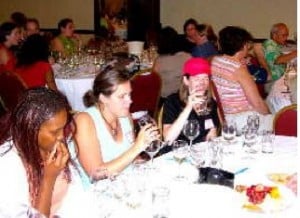
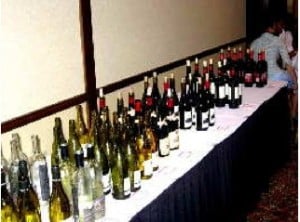 Unless your people can teleport wine into their faces, you MUST FIND A VENUE! OK, but how? Couple thoughts..the most obvious venue is the place you work or hangout, maybe someone’s home. Before you make the phone call to a Professional Event Planner (that’s what wine speakers/professionals become from necessity – we have no choice!), ask a friend/co-worker if they know a nice place to hold a wine tasting. Most likely, a short brain-storming session will begin and potential spaces will be considered – someone’s new home, a great meeting place the group already frequents, a winery, etc..DO THIS BEFORE YOU MAKE THE CALL..OK, I have a confession..
Unless your people can teleport wine into their faces, you MUST FIND A VENUE! OK, but how? Couple thoughts..the most obvious venue is the place you work or hangout, maybe someone’s home. Before you make the phone call to a Professional Event Planner (that’s what wine speakers/professionals become from necessity – we have no choice!), ask a friend/co-worker if they know a nice place to hold a wine tasting. Most likely, a short brain-storming session will begin and potential spaces will be considered – someone’s new home, a great meeting place the group already frequents, a winery, etc..DO THIS BEFORE YOU MAKE THE CALL..OK, I have a confession..
Over HALF the phone calls I receive requesting a wine tasting are VENUE SEEKERS, ie. they could care less about a wine tasting, they just want to squeeze my brain for all the venues I know and just work directly with them..But that’s another Subject!
Back to your needs..hotels and restaurants should be your last choice – why? Because they charge many fees that raise the cost quickly and significantly: room/rental fees, food minimums, corkage fees for wine (a little more on this below..), plus taxes and surcharges on top of all that. Many restaurants and hotels don’t allow an outside vendor to bring wine into their facility – of course – they can sell their own wine to you for a 250-400% markup (this is a common cost multiplier – a $6 store bought wine being sold in a hotel for $21.50 to $30 a bottle ++)
Since cost is a major factor to over 90% of the people that call requesting a wine tasting, think cost first – a free venue is the best. What free venues are available to most people? A home comes to mind first, so contact friends who have a nice place, or who for whatever reason (Ego!) want to show-off their abode. What about an apartment complex – many have community rooms that are empty most of the time, and if you know someone who’s a tenant in the complex, that helps a bunch! Some other potential “free” or low-cost venues include office spaces, office building atriums, art galleries, and non-profit spaces. A note about art galleries and other public venue – they may have quite a few restrictions..well, that’s another article, Cheers!
Charlie “I Drink on the Job” Adler – Check out my book NOW Available on Kindle or Soft-Cover – I Drink on the Job
A Wine Tasting – What’s in a Name?
I’ve organized or promoted over 1,000 wine tastings and wine classes in the Washington, D.C. area since 1997 through my organization TasteDC.com. A few times a week I get a phone call at headquarters (a room in my Georgetown townhouse with 2 computers, a color printer and a Fax..but it IS Ground Zero for DC wine tastings!) asking me to organize a wine tasting or class for a group of say maybe 15 people. What’s funny/unfortunate/amazing is that the call is almost always the same – THEY HAVE NO IDEA WHAT A WINE TASTING IS OR WHAT THEY’RE LOOKING FOR!
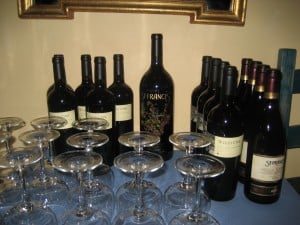 A wine tasting is an event from the TasteDC perspective – it has a beginning time, an ending time and a theme to fill the middle of the tasting. Say for example, a wine tasting of wine styles: rent a room, supply it with glassware (maybe a little food – cheese, crackers and bread would be nice!), a selection of wines with say three different “styles” (could be anything, but normally it might be light-bodied, medium-bodied and heavy-bodied wines) and put them at their own tables with volunteers pouring the wine..or people could pour their own wine – then we suggest you put out an information tasting sheet on each wine..
A wine tasting is an event from the TasteDC perspective – it has a beginning time, an ending time and a theme to fill the middle of the tasting. Say for example, a wine tasting of wine styles: rent a room, supply it with glassware (maybe a little food – cheese, crackers and bread would be nice!), a selection of wines with say three different “styles” (could be anything, but normally it might be light-bodied, medium-bodied and heavy-bodied wines) and put them at their own tables with volunteers pouring the wine..or people could pour their own wine – then we suggest you put out an information tasting sheet on each wine..
RECAP:
- Do you have a Date?
- Do you have a Venue?
- Do you have a wine “theme”?
There are literally thousands of ways to organize a wine tasting! I do want to make note – if you use the term “wine class” that most likely means a seated event with a speaker. Does a wine tasting necessarily need a speaker? No – the simple answer is sometimes (most of the time!) a speaker ads an unnecessary expense to a tasting – speakers charge for their services and the fees range significantly (I start at about $500 per event, but I have other ways to increase my profitability – hey, don’t attendees want a copy of my book “I Drink on the Job” ?
I’m going to write more about what to look for in a wine tasting – both for a private group and for a fun public form of entertainment – keep checking back – Cheers!
Charlie “I Drink on the Job” Adler
The Grouponater Effect
I knew the day would come, but I was pushing it off as long as possible..after 14 years, over 1,000 wine tastings, 200 cooking classes and dozens of specialty culinary events (Unique Food and Wine Festival, Chorizo Making class, etc.) would I give up TasteDC?? I knew some current facts:
The game had changed post 2008 Recession:
People spent their home’s future value – the ’08 Recession in a nutshell..banks were lending against a home’s equity..or estimated equity..a bubble..yep, it burst, go figure! When you run a small tasting event business, you need to focus on high margin, low volume events – in other words, lots of small wine classes, cheese tastings, and an occasional mini-festival. I never reached Big for the large events preferring to stay with a small staff (often just me and part-time help!) and slowly increasing the number of events. From 1997 to 2007, TasteDC went from organizing one event a month to as many as fifteen a month. When the bubble burst, people didn’t want to splurge – no one wanted to act like they had any disposable income, it just wasn’t the thing to do. My business dropped by over 50%..
Perceptions of value had changed:
In 1999 a wine dinner was something pretty unique and unusual – wine lovers were still a rarified group who often spoke in a language that no one understood. Wine was prestigious, intellectual and sophisticated and the people who drank it often travelled around or had lived abroad, were college educated and possibly even a bit snobbish. Wine dinners – defined as multi-course seated meals with at least one wine paired per course (but often 2 or more wines per course!) and normally a wine presenter discussing the pairings were relatively expensive – a 4 course wine dinner at a fine dining restaurant would cost you $85 to $150 per person inclusive of tax and tip. Believe it or not, many of these dinners sold out at 35+ people and there never seemed to be enough inventory of this kind of event.
Over time, wine became less prestigious and more of a daily consumable – this is actually a good thing. No longer is wine placed on a pedestal, it’s something you can pick up for a meal at the local grocery store or 7-11 and even casual dining restaurants normally carry at least 20 different kinds of wine in the DC area. Economically speaking, wine dinners have actually gone down in price and consumer perception of value – today, a 5-course wine dinner is often under $100 per person, and many of them barely get ten people to sign-up.
And recently, wine dinners are being replaced with the newest premium beverage to hit the DC Foodie scene – craft beer dinners. Most craft beer dinners are 5-courses and under $70 per person inclusive of tax and tip. Craft beer is perceived to be more approachable and fun than wine, so these dinners are often raucous affairs with a younger more urban crowd. Frankly, these dinners are refreshing to the wine dinner scene which seemed to be constantly inundated by the new rich who just wanted to make sure that everyone knew about their newly built wine cellar in their McMansion and the value of their recent stock option sales. Beer is real, or as I often here quoted “It’s just f***ing beer!”
The Groupon Effect:
This only occurred in 2010 or so, but has had a huge impact – when Groupon, LivingSocial and other online coupon companies began to discount restaurants and stores, it was only a matter of time before events and promotions also began discounting. I makes sense – these sites have millions of potential users and they can really bring new customers. The problem is primarily two-fold: the cost of “grouponing” and the “wait and see” attitude it creates.
If your event is say $70/person, then Groupon will suggest 50% off, so they will sell your ticket at $35/person. Groupon makes money by taking 50% of YOUR HALF, so that means you net $17.50 (LivingSocial and some other sites often don’t take as high a percentage). You can see that as a gain of new consumers and some money, but normally an event doesn’t have higher than a 50% margin, and often lower. Events make money once their fixed costs are covered – stating the obvious. Some of an event’s cost is often covered by corporate/retail sponsors, but in a slow economy, these sponsorships are hard to come by – event tickets are the main income..so how do you make money at $17.50/person? Good question..
I know I’ve only touched the surface of this subject, but the bottom-line is that the ROI on tasting events – the wine classes, cooking classes and other tastings that TasteDC specialized in – has become so low, it’s often negative. Will it ever come back? Who knows..Is TasteDC a dead business proposition..well, not quite yet, there is an alternative business plan, and no it is not a discounting concept, stay tuned..
Cheers!
Charlie “I Drink on the Job” Adler
Cooking with Rum – Legg Mason Chef Challenge Monday, August 1st, 2011
Hey – you get to watch Professional Tennis and you get to taste these two chefs competing while cooking with Rum! I’m not really doing anything other than enjoying the event, but remember – I Drink on the Job – Cheers!
Chef Challenge – Experience the Flavor of Puerto Rico hosted by Rums of Puerto Rico Reception: 6pm-8pm
Tickets: $70/person – PURCHASE TICKETS HERE – LEGG MASON CHEF’S CHALLENGE
Rums of Puerto Rico hosts Chef Challenge – Experience the Flavor of Puerto Rico, pitting Executive Chef Roger Villalobos of Mio Restaurant against Executive Chef Raynold Mendizabal of Lima Restaurant in a battle to determine who most masterfully creates flavorful and original Latin dishes infusing a variety of rums as theme ingredients.
The entertaining culinary showdown will take place on Monday, August 1st from 6 until 8 pm, in the tournament’s Hospitality Tent. Among the judges are International Tennis Hall of Famer Gigi Fernandez – the first-ever female Puerto Rican athlete to turn professional, Shannon Shaffer – Executive Chef of Design Cuisine, Mary Beth Albright – 2011 Food Network Star finalist and WTOP’s Man About Town Bob Madigan. Judges will sample both chef’s dishes and rate on taste, look/presentation and creativity to determine the Chef Challenge champion! NBC 4’s Eun Yang will be the emcee entertaining the audience throughout the competition.
The judges will prepare the First Course using DonQ rum, the Second Course using Bacardi rum and the Dessert Course using Barrilito rum.
Tickets for the Chef Challenge competition hosted by Rums of Puerto Rico includes food and drink during the reception, a ticket to all the Monday session main draw matches, and the chance to meet Hall of Famer Gigi Fernandez, all for just $70.
Availability is limited, so call the Tournament Hotline at 202-721-9500 or visit
http://www.leggmasontennisclassic.com to reserve your spot.
A Bit On Bordeaux..
Who says wine tastings are boring? On Tuesday, April 20th I attended a wine tasting sponsored by MacArthur’s Beverages at the Matisse Restaurant in Washington, D.C. with Jeffrey Davies, a well-known Bordeaux negociant, importer, and wine maker who actually is originally from the U.S. The event was to showcase the wines of Stephane Derenoncourt who unfortunately couldn’t make it because of the Icelandic volcano that erupted ash all over Europe and prevented him from flying into DC. This video is brief and covers some of the differences in how vines are chosen for the Right Bank vs. the Left Bank of Bordeaux. It was quite an educational experience for me as the tasting notes were extensive on the printed tasting sheet and included terms I was vaguely familiar with including microbullage and levurage
Twelve wines were tasted from a Gree Laroque 2005 priced at $20 to La Mondotte 2001 which will set you back $200 or so a bottle! There was also a special guest appearance by a winery that Monsieur Derenoncourt consults with in Virginia called Boxwood Winery – both the Boxwood Topiary Red 2007 and the Estate Red 2007 both at about $25/bottle showed very well against the French Bordeauxs – Rachel Martin, one of the owners spoke about making wine in Virginia at the event.

Oh, and for fun, here’s the video of Jeffrey on Wine Library TV:
Mind Your P’s and Q’s – Wine Tastings at Embassies
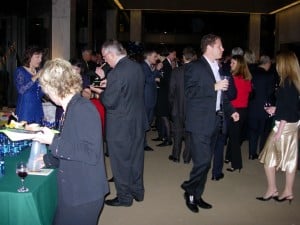
Embassy of France – TasteDC Beaujolais Celebration 2004
Click Here for Photos from TasteDC’s First Embassy Wine Tasting in 1998
Living in Washington, D.C. has many benefits, especially the fact that almost every country in the world has an Embassy in our city – and many either organize or allow for events such as wine tastings. I’m not exactly sure which was my first Embassy wine tasting experience, but I do remember sometime in the 90’s attending an “Opera and Wine Tasting” at the Spanish Embassy..or was that the Spanish Ambassador’s Residence? What I remember is that it was very dressy, the Ambassador was not there, and the opera singer kept forgetting the words to the opera..oh, and there was plenty of wine to sample! Since that time, I personally have organized over 40 events at Embassies through my company TasteDC and I’ve learned quite a bit about the do;s and dont’s of organizing an event at an Embassy?
1) Choose Wines from a Variety of Growing Regions in the Country
This seems like common sense, but unless I’m organizing a region specific event like the Champagne event or the Beaujolais Nouveau events I’ve held at the French Embassy, it’s best to have a broad cross section of wines from various regions.
2) Hire a Caterer Who Understands the Cuisine and Preparation
I’ll tread on this one lightly – I once hired a French caterer to prepare the cheese fondue at a Swiss Embassy Chocolate, Cheese and Wine Event..and the fondue clumped together! Wow, did the Embassy official who looked at the mess get upset – it was also very hard to get on people’s plates, oh well. It also took us almost 2 hours to figure out how to turn on their oven in the basement kitchen, it needed an old-fashioned match to light the pilot..I could go on and on about mis-haps with Embassy kitchens (food ending up in the purses of Embassy staff, chefs not showing up,etc..), but I also want to include that most of the time things have worked out well. If you’ve ever organized a large event, things will go wrong, that’s to be expected.
3) Be Ready to Bear the Financial Risk
After 10 years of organizing these events for 200+ people, I just decided that it took too much energy to continue to run these hectic events – not only are they time-consuming and difficult, but I was at financial risk. Normally, an embassy charges some kind of rental fee, and of course, the caterer, food, wine and staff are all fixed costs, so many events don’t even break-even until 100 tickets are sold. When I first began holding events at embassies in 1998, there were very few organizations doing so for profit. Of course, once my business took off, every other event promoter in DC began to contact the embassies and do the same or similar events. Sales declined, prices came down, and frankly the amount of sweat and effort it took to make a successful event just didn’t make sense.
OK, this was fun going down memory lane..I think I’ll write more about Embassy tastings in the D.C. area – if you are curious about what it’s like to work with an Embassy, leave me a comment or email me – oh, here are some more photos of an Austrian wine tasting at the Austrian Embassy – – Cheers!
Charlie “I Drink on the Job” Adler
If You Evaluate Wine, Then Why Not Food?
This was a crazy week for me, so I’m just starting to wind down and think about it more. I was on the “Thunder Show” with Gary V on Monday (although it went up on Wednesday), traveled back to DC through the snow and began in earnest to market my book the rest of the week, with a small respite for a “Unique Spirits 101” class that I organized with my full-time gig TasteDC. I always like to look back at my week and try to sift through what was important, what I learned and if I need to avoid any situations. I sort of live in a bubble – all I care about is promoting my message – wine and food were meant to be together – and that’s become my life goal, better not get in the way!
I love wine, and I love food, so I’m in a bit of a quandary (a common state for me!)..why is it in the wine world that we try to evaluate and break down wine, but in the food world, it only happens in rare occasions such as competitions..a little vague, but let me explain. Whenever I’m teaching a class on wine like my “Wine Basics 101” class at TasteDC, attendees always ask me to “explain” what I’m tasting. People who are attending a wine class obviously want to learn more about wine, but I’m not sure why they want to know what I’m tasting – does it translate well to their taste buds? If I taste spearmint, blackberry and tobacco, and you taste peppermint, cranberry and honey, who’s right? By breaking down the components of the “taste” of wine, do I make it any easier for a beginner wine drinker to understand the wine? Will the attendee be empowered by the experience or intimidated, and ultimately, will it get the person to purchase more wine?
First of all, I don’t have the answer, that’s why I’m in a quandary – there is no answer, sometimes just looking at the question brings awareness to the situation (my Zen side!). So I posed an additional question to myself: if we break down wine into its individual parts, shouldn’t we do so for food as well? In my book “I Drink on the Job” I spend alot of time talking about the connection between food and wine. I have one quote – read it, consider it, make a picture of it in your mind:
Americans don’t seem to trust their sense of taste with wine. If you like steak, then you don’t need anyone to tell you if it’s good or not; you’ve enjoyed steak since you were young and you know what you like–medium or medium-rare, one-inch thick, two-inch, rib eye, filet or strip–even if someone else disagrees. We have no experience with wine as a culture, so we seek peer approval..
